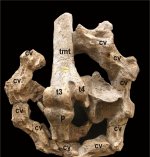Fred Ruhe
Well-known member

Eric Buffetaut, 2022
The First-Named Fossil Ostrich: A Revision of Struthio asiaticus, from the Siwaliks of India
Diversity. 14 (10). 860.
doi:10.3390/d14100860
Abstract and free pdf: file:///C:/Users/Fred/Downloads/diversity-14-00860.pdf
The first fossil ostrich to have been named, by Milne-Edwards in 1869–1871, was Struthio asiaticus, a taxon based on a specimen collected by Colonel Colvin in the Siwaliks of India, consisting of associated postcranial elements (vertebrae, forelimb elements, a fragmentary tarsometatarsus and first phalanx of the third toe). Although it was described as least twice in some detail in the 19th century, the specimen has since then been interpreted in conflicting ways. A revision of the type material and its history shows that it came in all likelihood from the Siwaliks of present-day India, not Pakistan. The exact locality is unknown and the stratigraphic position of the specimen is uncertain (the frequent attribution to the Dhok Pathan Formation is not based on solid evidence). Contrary to what has sometimes been claimed, Struthio asiaticus was neither a small nor an especilly large ostrich. It was apparently comparable in size with the modern S. camelus, but had slightly more robust cervical vertebrae and carpal bones. It seems to have been relatively short-toed. Because of the incompleteness of the material and uncertainties about its geological age, it is difficult to assess the place of Struthio asiaticus in the evolutionary history of the ostriches. Reports of Struthio asiaticus from Africa and north-eastern Asia are based on misinterpretations and should be discarded.
Enjoy,
Fred
The First-Named Fossil Ostrich: A Revision of Struthio asiaticus, from the Siwaliks of India
Diversity. 14 (10). 860.
doi:10.3390/d14100860
Abstract and free pdf: file:///C:/Users/Fred/Downloads/diversity-14-00860.pdf
The first fossil ostrich to have been named, by Milne-Edwards in 1869–1871, was Struthio asiaticus, a taxon based on a specimen collected by Colonel Colvin in the Siwaliks of India, consisting of associated postcranial elements (vertebrae, forelimb elements, a fragmentary tarsometatarsus and first phalanx of the third toe). Although it was described as least twice in some detail in the 19th century, the specimen has since then been interpreted in conflicting ways. A revision of the type material and its history shows that it came in all likelihood from the Siwaliks of present-day India, not Pakistan. The exact locality is unknown and the stratigraphic position of the specimen is uncertain (the frequent attribution to the Dhok Pathan Formation is not based on solid evidence). Contrary to what has sometimes been claimed, Struthio asiaticus was neither a small nor an especilly large ostrich. It was apparently comparable in size with the modern S. camelus, but had slightly more robust cervical vertebrae and carpal bones. It seems to have been relatively short-toed. Because of the incompleteness of the material and uncertainties about its geological age, it is difficult to assess the place of Struthio asiaticus in the evolutionary history of the ostriches. Reports of Struthio asiaticus from Africa and north-eastern Asia are based on misinterpretations and should be discarded.
Enjoy,
Fred
Last edited:




